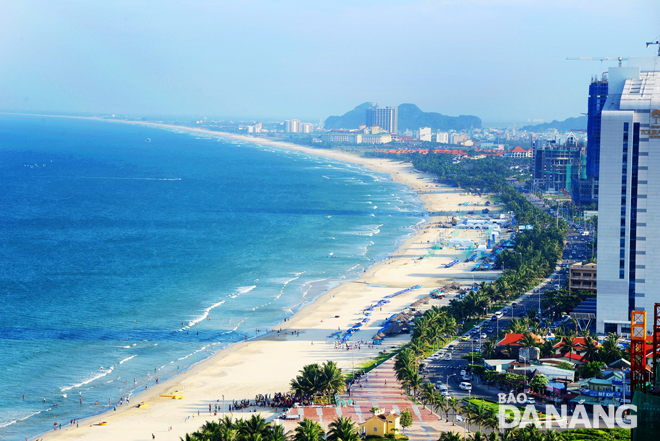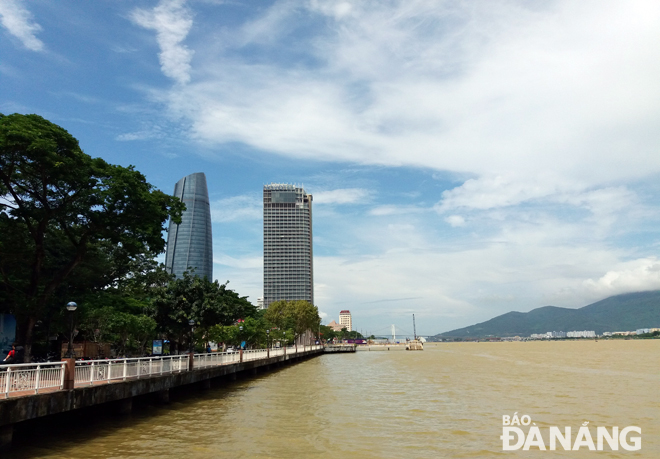Solutions sought to build Da Nang into green and sustainable city
Discussions about building Da Nang into a green and sustainable city, and developing urban planning strategies for the city’s progress in a scientific manner were in the spotlight at a recent workshop on urban planning orientations.
 |
| A prosperous corner of the city |
The event was co-organised by the national and municipal Urban Planning and Development Associations, under the chair of the city’s People's Committee Vice Chairman Dang Viet Dung.
Architect Tran Ngoc Chinh, the Chairman of the Viet Nam Urban Planning and Development Association, who once got involved in developing a master plan for Da Nang’s progress, remarked, “In recent years, Da Nang has nationally pioneered in urban planning and development management”.
Ms Le Thi Bich Thuan, the Deputy Director of the Institute for Urban Studies & Infrastructure Development under the Viet Nam Federation of Civil Engineering Associations, suggested that Da Nang should focus on medium-term development strategies based on the plans for functional zone development, ensuring the city’s green growth and sustainable development, promoting its brand name following the great success of the APEC Economic Leaders’ Week 2017.
Currently, possessing more than 20,000 ha of urban land, the city is actively adjusting its master plan by 2035, with a vision towards 2050, in order to realise its goal of developing into an environmentally friendly and smart urban hub.
Architect Ngo Viet Nam Son, the Chairman of the Ho Chi Minh City-based Ngo Viet Design Consultants Company, underlined the importance of developing marine tourism and riverside urban areas and a similar venue near the Da Nang International Airport to create more new landmarks for the city in the current context of land shrinking due to urbanisation.
In the airport’s future urban area, it is good idea to re-plan infrastructure within a 1-2km radius of the airport, with special heed to building a ring route for the sake of efficient upgrade of the venue and the development of logistics and trade sectors.
 |
| Green space along the western bank of the Han River |
Director of the municipal Construction Department Vu Quang Hung underlined a need to re-develop downgraded urban areas which no longer meet the requirements in terms of essential infrastructure in the current context of challenges of rapid population growth.
Alongside, it is also necessary to consider promoting urban expansion in the subsequent periods by fostering the marine economic growth of the Da Nang Bay and nearby areas, as well as steeping up the urban development towards the west in a scientific and effective way.
In his ideas about the relocation of the Da Nang Airport, Architect Ngo Viet Nam Son said that Singapore is focusing on developing the Changi Airport towards the ‘airport-led urban area’ model Meanwhile, Mr
Mr Bui Van Tieng, the Chairman of the city’s Historical Science Association, noted that the relocation of the airport to the Trang Nhat area in Quang Nam Province’s Dien Ban District is better than such proposed sites as the sea and Chu Lai.
Mr Tieng also noted that the relocation of the airport should be conducted on the basis of national interests, in line with the Politburo’s Directive No 33-NQ/TW about promoting the progress of Da Nang in the current context of the country’s industrialisation and modernisation, whilst ensuring the city’s firm stature as an international gateway for the whole central region.
Addressing the workshop, Standing Vice Chairman Dung re-affirmed Da Nang’s stance in ensuring the vital role of natural values in creating the natural structure in the heart of the city to preserve its characteristics.
Urban restructuring should be accelerated in the right direction of developing even more green spaces and community facilities, building the urban image featuring a good public transport system, and fully tapping the potential of underground space.
Last, but not least, importance should be attached to developing Da Nang into a smart city with abundant public utilities.